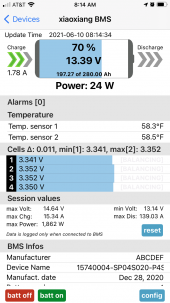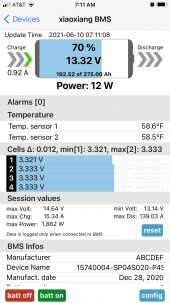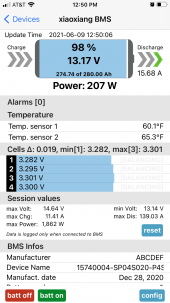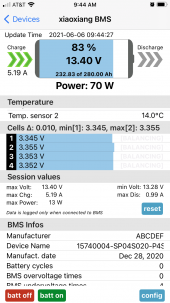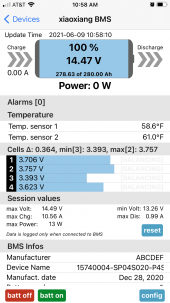I just completed my diy lifepo battery install in my small rv. It consists of a 12 V 280 ah 4 cell battery with JBD 120amp BMS. It's being charged by a victron SCC(configured for lifepo charging). I'm sharing some photos of the cell reading on the first day that it reached full charge after assembly. Prior to assembly, I top balanced the cells.
I installed the battery this week and I noticed that 3 or 4 cells had maxed out at just above 3.7XX volts and the BMS was shutting down on the first day it reached capacity(I had drawn down about 40 ah testing it out). Everything seems to work fine.
In trying to understand what is happening, I think that those 3 are "closer to full" and that's why they jump and the BMS protects kicks in. I noticed that when there is a draw on the battery, the cells differential closes, and the next morning they were all within 0.019 volts of each other.
My questions: Is this harmful to the battery? Is there a setting on my BMS that should be adjusted to prevent this? This will not be a high usage battery in my RV, and will often sit at or near full except when in use. If anyone has suggestions, I'd love to hear them.
If it's a minor issue and can be left alone that would be great to know as well.
I installed the battery this week and I noticed that 3 or 4 cells had maxed out at just above 3.7XX volts and the BMS was shutting down on the first day it reached capacity(I had drawn down about 40 ah testing it out). Everything seems to work fine.
In trying to understand what is happening, I think that those 3 are "closer to full" and that's why they jump and the BMS protects kicks in. I noticed that when there is a draw on the battery, the cells differential closes, and the next morning they were all within 0.019 volts of each other.
My questions: Is this harmful to the battery? Is there a setting on my BMS that should be adjusted to prevent this? This will not be a high usage battery in my RV, and will often sit at or near full except when in use. If anyone has suggestions, I'd love to hear them.
If it's a minor issue and can be left alone that would be great to know as well.



